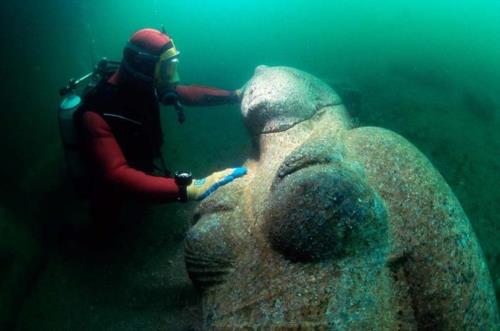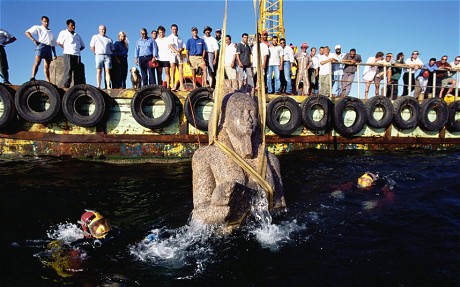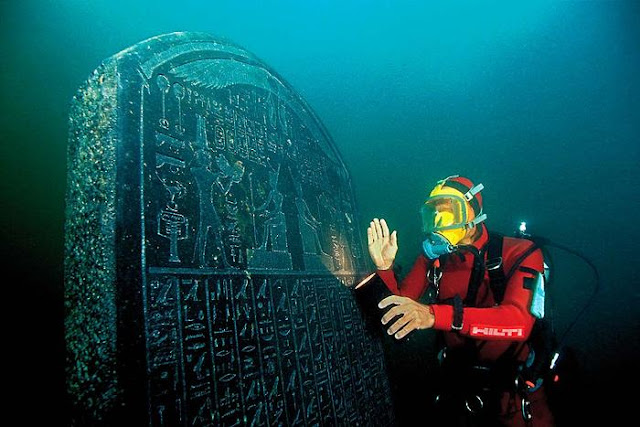 http://www.themindunleashed.org/2013/07/lost-egyptian-city-found-underwater.htmlLost Egyptian City Found Underwater After 1,200 Years
http://www.themindunleashed.org/2013/07/lost-egyptian-city-found-underwater.htmlLost Egyptian City Found Underwater After 1,200 YearsA lost ancient Egyptian city submerged beneath the sea 1,200 years ago was
discovered and is revealing what life was like in the legendary port of
Thonis-Heracleion.

For centuries it was thought to be a legend, a city of extraordinary wealth
mentioned by Herodotus, visited by Helen of Troy and Paris, her lover, but
apparently buried under the sea. In fact, Heracleion was true, and a decade
after divers began uncovering its treasures, archaeologists have produced a
picture of what life was like in the city in the era of the pharaohs. The city,
also called Thonis, was found during a survey of the Egyptian shore at the
beginning of the last decade.

1,200 years ago the ancient Egyptian city of Heracleion disappeared beneath the
Mediterranean. Founded around 8th century BC, well before the foundation of
Alexandria in 331 BC, it is believed Heracleion served as the obligatory port
of entry to Egypt for all ships coming from the Greek world. Prior to its discovery
in 2000 by archaeologist Franck Goddio and the IEASM (European Institute for Underwater
Archaeology), no trace of Thonis-Heracleion had been found (the city was known to the
Greeks as Thonis). Its name was almost raised from the memory of mankind, only preserved
in ancient classic texts and rare inscriptions found on land by archaeologists.
 The Discovery
The DiscoveryWith his unique survey-based approach utilising sophisticated technical equipment, Franck Goddio
and his team from the IEASM were able to locate, map and excavate parts of the city of Thonis-Heracleion,
which lies 6.5 kilometres off today’s coastline about 150 feet underwater. The city is located within
an overall research area of 11 by 15 kilometres in the western part of Aboukir Bay. [Source]
Findings to date include:
- The remains of more than 64 ships buried in the thick clay and sand that covers the sea bed
- Gold coins and weights made from bronze and stone
- Giant 16-ft statues along with hundreds of smaller statues of minor gods
- Slabs of stone inscribed in both ancient Greek and ancient Egyptian
- Dozens of small limestone sarcophagi believed to have once contained mummified animals
- Over 700 ancient anchors for ships
 What Caused the Submergence?
What Caused the Submergence?Research suggests that the site was affected by geological and cataclysmic phenomena. The slow
movement of subsidence of the soil affected this part of the south-eastern basin of the Mediterranean.
The rise in sea level also contributed significantly to the submergence of the land. The IEASM
made geological observations that brought these phenomena to light by discovering seismic effects
in the underlying geology. Source
Analysis of the site also suggests liquefaction of the soil. These localized phenomena can be
triggered by the action of great pressure on soil with a high clay and water content. The pressure
from large buildings, combined with an overload of weight due to an unusually high flood or a tidal
wave, can dramatically compress the soil and force the expulsion of water contained within the
structure of the clay. The clay quickly loses volume, which creates sudden subsidence. An earthquake
can also cause such a phenomenon. These factors, whether occurring together or independently, may
have caused significant destruction and explain the submergence of Thonis-Heracleion.
